Huangqi Guizhi Wuwu Decoction Improves Arthritis and Pathological Damage of Heart and Lung in TNF-Tg Mice
- PMID: 35600883
- PMCID: PMC9114745
- DOI: 10.3389/fphar.2022.871481
Huangqi Guizhi Wuwu Decoction Improves Arthritis and Pathological Damage of Heart and Lung in TNF-Tg Mice
Abstract
Background: Huangqi Guizhi Wuwu Decoction (HGWD) is a traditional and effective Chinese medicine compound decoction for the treatment of rheumatoid arthritis (RA). However, there is few research on the treatment of rheumatoid cardiopulmonary complications. The present study was to study whether HGWD can alleviate the pathological changes caused by rheumatoid arthritis and cardiopulmonary complications. Methods: Five 3-month-old TNF-Tg mice were treated with HGWD (9.1 g/kg) once a day or the same dose of normal saline lasted for 8 weeks, and wild-type littermates of the same age were used as a negative control, and methotrexate (MTX) was intraperitoneally administered as a positive control. After the treatment, pathological staining was performed on the mouse ankle joints, heart, and lungs. Result: It was found that HGWD reduced the inflammation of the ankle joint synovium in TNF-Tg mice, and reduced myocardial hypertrophy, inflammatory infiltration and fibrosis of heart, as well as lung inflammation and fibrosis. Immunohistochemical staining with anti-TNF-α antibody showed that HGWD reduced the expression of TNF-α in the heart of TNF-Tg mice. Conclusion: In conclusion, HGWD alleviates joint inflammation in TNF-Tg mice and reduces the pathological changes of the heart and lungs.
Keywords: Huangqi Guizhi Wuwu Decoction; TNF-Tg mice; cardiopulmonary complications of RA; rheumatoid arthritis; traditional Chinese medicine.
Copyright © 2022 Wang, Chen, Yang, Li, Ma, Xu, Shi, Wang, Wang and Liang.
Conflict of interest statement
The authors declare that the research was conducted in the absence of any commercial or financial relationships that could be construed as a potential conflict of interest.
Figures
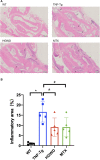

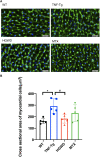
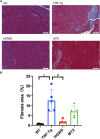
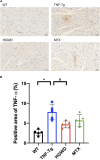
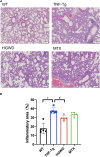

Similar articles
-
Huangqi Guizhi Wuwu Decoction suppresses inflammation and bone destruction in collagen-induced arthritis mice.Chin Herb Med. 2024 Jan 11;16(2):274-281. doi: 10.1016/j.chmed.2023.10.003. eCollection 2024 Apr. Chin Herb Med. 2024. PMID: 38706818 Free PMC article.
-
Huangqi Guizhi Wuwu decoction alleviates oxaliplatin-induced peripheral neuropathy via the gut-peripheral nerve axis.Chin Med. 2023 Sep 7;18(1):114. doi: 10.1186/s13020-023-00826-5. Chin Med. 2023. PMID: 37679804 Free PMC article.
-
The efficacy and safety of Huangqi Guizhi Wuwu decoction for rheumatoid arthritis: A protocol for systematic review and meta-analysis.Medicine (Baltimore). 2020 Sep 4;99(36):e22011. doi: 10.1097/MD.0000000000022011. Medicine (Baltimore). 2020. PMID: 32899051 Free PMC article.
-
Study on the Efficacy and Safety of the Huangqi Guizhi Wuwu Decoction in the Prevention and Treatment of Chemotherapy-Induced Peripheral Neuropathy: Meta-Analysis of 32 Randomized Controlled Trials.J Pain Res. 2024 Aug 8;17:2605-2628. doi: 10.2147/JPR.S466658. eCollection 2024. J Pain Res. 2024. PMID: 39139997 Free PMC article. Review.
-
Efficacy and Safety of GuiZhi-ShaoYao-ZhiMu Decoction for Treating Rheumatoid Arthritis: A Systematic Review and Meta-Analysis of Randomized Clinical Trials.J Altern Complement Med. 2017 Oct;23(10):756-770. doi: 10.1089/acm.2017.0098. Epub 2017 Jun 13. J Altern Complement Med. 2017. PMID: 28609129 Review.
Cited by
-
Chemical Differentiation and Quantitative Analysis of Black Ginseng Based on an LC-MS Combined with Multivariate Statistical Analysis Approach.Molecules. 2023 Jul 6;28(13):5251. doi: 10.3390/molecules28135251. Molecules. 2023. PMID: 37446911 Free PMC article.
-
Huangqi Guizhi Wuwu decoction improves hemorheology and inhibits inflammatory response after PCI for acute myocardial infarction.Am J Transl Res. 2023 May 15;15(5):3686-3696. eCollection 2023. Am J Transl Res. 2023. PMID: 37303648 Free PMC article.
-
Exploring the potential anti-diabetic peripheral neuropathy mechanisms of Huangqi Guizhi Wuwu Decoction by network pharmacology and molecular docking.Metab Brain Dis. 2024 Nov 20;40(1):20. doi: 10.1007/s11011-024-01474-w. Metab Brain Dis. 2024. PMID: 39565454
-
Network pharmacology prediction and molecular docking-based strategy to discover the potential pharmacological mechanism of Huang-Qi-Gui-Zhi-Wu-Wu decoction against deep vein thrombosis.J Orthop Surg Res. 2023 Jun 30;18(1):475. doi: 10.1186/s13018-023-03948-6. J Orthop Surg Res. 2023. PMID: 37391801 Free PMC article.
-
Exploration of the mechanism by which Huangqi Guizhi Wuwu decoction inhibits Lps-induced inflammation by regulating macrophage polarization based on network pharmacology.BMC Complement Med Ther. 2023 Jan 9;23(1):8. doi: 10.1186/s12906-022-03826-4. BMC Complement Med Ther. 2023. PMID: 36624435 Free PMC article.
References
-
- Asanuma H., Sanada S., Ogai A., Minamino T., Takashima S., Asakura M., et al. (2004). Methotrexate and MX-68, a New Derivative of Methotrexate, Limit Infarct Size via Adenosine-dependent Mechanisms in Canine Hearts. J. Cardiovasc. Pharmacol. 43 (4), 574–579. 10.1097/00005344-200404000-00013 - DOI - PubMed
-
- Bell R. D., White R. J., Garcia-Hernandez M. L., Wu E., Rahimi H., Marangoni R. G., et al. (2020). Tumor Necrosis Factor Induces Obliterative Pulmonary Vascular Disease in a Novel Model of Connective Tissue Disease-Associated Pulmonary Arterial Hypertension. Arthritis Rheumatol. 72 (10), 1759–1770. 10.1002/art.41309 - DOI - PMC - PubMed
LinkOut - more resources
Full Text Sources
Miscellaneous

